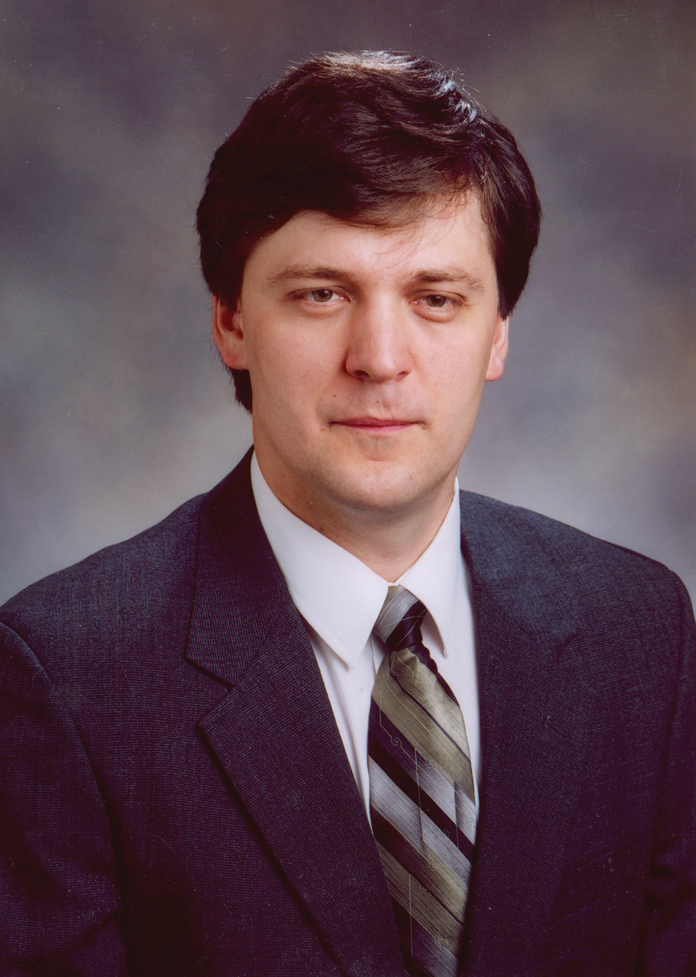Contact: Phil Hearn

Yaroslav Koshka
Mississippi State researchers are using a grant of more than $730,000 to perfect silicon carbide material technology that may help the U.S. Navy develop new high-power radar systems.
The Office of Naval Research award of $731,858 to the university's Emerging Materials Research Laboratory also may help promote the state's semiconductor industry.
MSU researchers will develop specialized material fabrication processes potentially important to development of silicon carbide--SiC--radio-frequency transistors for radar and other specific Navy and Marine Corps applications.
"We are trying to employ the latest developments in semiconductor physics, material science and chemistry," said principal investigator Yaroslav Koshka, an assistant professor in the department of electrical and computer engineering, administrative home to EMRL. The department is headed by James C. Harden.
Scientists say the small, circular SiC wafers are used in high-voltage, high-temperature and high-frequency applications. They note SiC epitaxial growth is one of the more significant processes used to fabricate transistors.
SemiSouth Laboratories, a small Starkville-based business established in 2001 to commercialize SiC device technology, is one potential user of the material processes being developed by the MSU researchers. The company is located adjacent to campus in the Thad Cochran Research, Technology and Economic Development Park.
"SemiSouth is likely to be interested in licensing some of the proprietary epitaxial processes that could be developed by MSU researchers during this project," said Koshka. "We anticipate that ongoing MSU research in the area of SiC material technologies will further contribute to development of the semiconductor industry in Mississippi."
Koshka said ONR support of the university's wide bandgap semiconductor research is recognition of earlier successful investigations led by department colleague and EMRL founder Michael S. Mazzola. According to research publications, wide bandgap semiconductors offer potential microwave power-frequency capability unavailable from existing technologies, and could revolutionize radar and communications transmitters.
Koshka said Charles U. Pittman Jr. also has become a valuable research ally in developing novel SiC epitaxial growth processes and simulation models. Pittman, a chemistry professor, is a co-principal investigator in the EMRL project.
"Silicon carbide is really good for high-power electronics and microelectronics because it has high breakdown electric field and saturated drift velocity, good temperature resistance and radiation resistance," said Pittman, noting high-quality SiC epilayers are grown in reactors at temperatures ranging from 1,400 to 1,800 degrees centigrade. "We're studying the chemical vapor deposition process in the reactor," he explained.
Koshka said the study of low-pressure chemical vapor deposition-based epitaxial growth--one of the project's fundamental research areas--involves "producing layers of SiC material of improved purity and crystal-quality at reduced temperatures."
He said another major part of the program, dubbed "defect engineering," targets development of novel material and device fabrication processes for SiC. New, interesting phenomena involving interaction of impurities in SiC have been discovered and published by the EMRL research team during the last few years, he added.
"A part of the program is devoted to investigating fundamental properties of electrically active defects in SiC and developing defect engineering techniques to influence semiconductor electrical and optical characteristics," Koshka said.
SemiSouth, a developer of SiC transistors, diodes and epiwafer products, is the leader of a team that received a $2.6 million contract from ONR last year to develop key fabrication processes for SiC RF transistors to use in high-power radar systems. Other members of the team include General Electric Global Research Center and MSU.
NEWS EDITORS/DIRECTORS: For additional information, contact Dr. Koshka at (662) 325-2411.